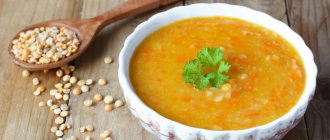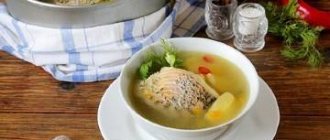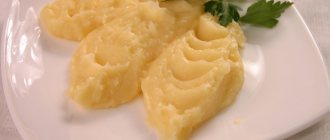Modern doctors recommend breastfeeding your baby until at least one year of age, and, if possible, longer. After all, mother’s milk contains all the substances necessary for the development of the baby. But the period when the child receives only milk and nothing more ends at approximately 4.5-5 months.
Photo: depositphotos.com. Author: AChubykin.
At this age, the baby's body weight approximately doubles. He is growing, increasing his pace and his motor activity. Naturally, this requires a large amount of energy, and healthy breast milk can no longer cover all needs. Therefore, at 4-5 months it is recommended to introduce vegetables into the child’s diet.
When to introduce complementary foods?
In most cases, when a child is ready to introduce complementary foods, he himself begins to show interest in the food that the family members around him eat. The baby begins to reach for the spoon and watches with interest how the adults eat.
In addition, complementary feeding must be introduced if the child does not get enough milk and begins to demand the breast much more often. Much depends on what kind of feeding the baby is on: whether he is fed mother's milk or artificial formula. For a formula-fed baby, complementary foods are introduced earlier than for a breastfeeding baby. So, for a baby who receives formula instead of mother's milk, complementary foods must be introduced at four to five months. The fact is that the mixture simply cannot contain the elements that breast milk contains, which means it does not contain all the substances and vitamins a baby needs. If the child feeds exclusively on mother's milk, then the introduction of complementary foods should begin no earlier than at five to six months of age.
It is important to adhere to the above recommendations, because by six months the child must receive additional food, because milk alone at this age is no longer enough for the baby to fully develop and grow. And he needs to get additional vitamins from other sources. It is at the age of six months that the baby’s digestive system is ready to consume various foods. In order for the baby’s body to more easily adapt to new food, complementary foods should be given before breastfeeding (formula).
Time frame
After the child’s body adapts to the first (vegetable) complementary food, it is time for the second – porridge. In this case, cereal dishes should be introduced gradually and only after vegetables have completely replaced one of the meals.
You can start the second complementary feeding at about 7-8 months. At this point, the child is already sitting well without any support and can hold objects in his hands, such as a spoon. At this age, it is allowed to include thicker dishes in the diet, which will expand the baby’s taste knowledge.
It is advisable to continue breastfeeding. Now the baby requires less mother's milk, so the mother may experience problems with the stability of lactation. To prevent the volume of breast milk from decreasing or disappearing completely, experts recommend offering complementary foods to the baby after morning breastfeeding. A list of herbs that increase lactation may also be useful.
Which products are introduced first?
As a rule, porridge is introduced first into complementary foods. However, there are some peculiarities here too, and which product to introduce first depends on the health status of the baby. Before introducing porridge into complementary foods, you need to know that for children who develop normally and have the weight and height characteristic of their age, vegetables and fruits are the first to be introduced into complementary foods. Fruits and vegetables are also the first to be introduced into complementary foods for children suffering from constipation and overweight. Porridge, in turn, is introduced first into complementary feeding for children who are not gaining weight well and for children who have very loose stools. If vegetables and fruits are introduced into the baby’s diet first, then porridge is introduced only after two to three weeks.
At what age can children eat wheat porridge?
The baby is fed millet for the first time after he has tried other types of cereals:
- rice;
- corn;
- oatmeal;
- buckwheat
Cereals contain a large amount of gluten, so the first introduction to cereals is postponed until the baby is 8 months old. If the child previously had an allergy to gluten, then the product is introduced only after a year.
Small children cannot cook from whole grains, as such a product is difficult to digest.
For the first complementary feeding, the grains are first ground, and only after that the porridge is cooked. After a year, it is allowed to prepare a dish from finely ground millet, and from coarse millet - only after a year and a half.
How to introduce porridge into complementary foods?
If the first complementary food is porridge, then you should know how to introduce porridge into complementary foods, and which porridge is best to start complementary feeding with. It is better to give preference to rice or buckwheat porridge. The fact is that all porridges contain protein, which is healthy, but it is difficult for the baby to digest it, and buckwheat and rice porridges have the best balanced protein composition. Therefore, rice and buckwheat porridge are ideal for the first feeding of an infant. In order to properly prepare porridge for feeding a baby, the cereal must first be thoroughly washed and then boiled in water. To get the porridge of the desired consistency, take 5-10 g of cereal per 100 ml of water.
The first porridge for the baby must be cooked in water, but under no circumstances in milk!
After the cereal is ready, it should be crushed using a blender or fork and boiled in a small amount of milk. The consistency of porridge for a baby should be like puree; it is unacceptable for there to be lumps in it. You can grind the cereal before cooking using a coffee grinder. There is no need to add salt or sugar to baby porridge. After each complementary feeding, you must give your baby a breast or a bottle. This way the baby will get used to new tastes faster.
Porridges are very healthy in their composition. They contain zinc, magnesium, potassium, selenium, as well as B vitamins necessary for the development of the baby. The most nutritious are oatmeal and buckwheat porridge. Oatmeal is rich in vegetable protein, fats and fiber, as well as minerals - iron, calcium, magnesium. Corn porridge is also rich in protein, fat and fiber, while rice porridge contains healthy dietary fiber. Porridges made from semolina, barley, wheat, corn, and oatmeal can be given to a child only in the eighth month of life. Eating such cereals can lead to constipation in infants. You should not start feeding your baby with multi-ingredient cereals. If a child suddenly develops an allergy to porridge, then with this approach it will be very difficult to track which component the allergic reaction occurred to. You can combine porridge with vegetables, for example, cook porridge with the addition of pumpkin. When the baby is nine months old, you can add some berries to the porridge. Pediatricians advise introducing porridge into an infant’s diet in the following sequence:
- buckwheat
- rice porrige
- wheat porridge
- corn porridge
- oatmeal
- mixed porridge
After one type of porridge is introduced into the infant's complementary feeding, you need to wait 7-10 days. Often, infants experience constipation or allergic reactions after the introduction of porridge. Therefore, only after making sure that no negative consequences have arisen can you introduce the next type of porridge.
You can prepare porridge yourself, or you can buy porridge at a baby food store or pharmacy. When choosing store-bought porridge, be sure to check the expiration date of the product. For infants, it is recommended to choose cereals that do not contain GMOs and gluten. You should also avoid cereals that contain sugar, fructose, flavorings and other artificial additives. Many young mothers are afraid to buy porridge in stores, fearing for its quality. In fact, packaged cereals are no less healthy than those prepared at home. Moreover, manufacturers of baby cereals make sure that their products are balanced and hypoallergenic for children of all ages. Just when choosing packaged porridge, you need to carefully read the instructions for its preparation and find porridge specifically for the age of the baby. In general, the cereals that are sold in pharmacies and baby food stores are fully adapted for the child’s body. In addition, it is difficult to overestimate the convenience of their use - they are very quick and easy to prepare! Porridges contain proteins, fats and carbohydrates that are healthy and necessary for a child. If you know how to introduce porridge into complementary foods and introduce porridge into your baby’s diet in a timely manner, then there will be no problems with the absorption of porridge by the child’s body.
Nutritional value of cereals - table
All cereals have their own value for the body. They contain vitamins, proteins, fats and carbohydrates in a certain amount. They also contain fiber, starch, ash and other substances.
| Groats | Oatmeal | Rice | Buckwheat | Hercules | Corn | Millet | Semolina |
| Kcal | 344,1 | 304,8 | 313,0 | 346,2 | 325,3 | 323,9 | 326,4 |
| Water, city | 12,0 | 14,0 | 14,0 | 12,0 | 14,0 | 14,0 | 14,0 |
| Belki, Mr. | 11,0 | 7,0 | 12,6 | 11,0 | 8,3 | 11,5 | 11,3 |
| Fats, Mr. | 6,1 | 1,0 | 3,3 | 6,2 | 1,2 | 3,3 | 0,7 |
| Carbohydrates, g. | 65,4 | 71,4 | 62,1 | 65,7 | 75,0 | 66,2 | 73,3 |
| Starch, Mr. | 54,7 | 73,7 | 63,7 | 59,2 | 70,4 | 64,8 | 70,3 |
| Klechatka, city | 2,8 | 0,4 | 1,1 | 1,3 | 0,8 | 0,7 | 0,2 |
| Zola, Mr. | 2,1 | 0,7 | 1,7 | 1,7 | 0,7 | 1,1 | 0,5 |
| Vitamin A, mg. | — | — | 0,006 | — | 0,2 | 0.01 | — |
| In 1, mg. | 0,5 | 0,08 | 0,4 | 0,4 | 0,1 | 0,4 | 0,1 |
| B 2, mg. | 0,1 | 0,04 | 0,2 | 0.1 | 0,07 | 0,04 | 0,07 |
| B 3, mg. | 0,9 | 0,4 | — | — | 0.3 | — | — |
| At 6, mg. | 0,3 | 0,2 | 0,4 | 0,2 | 0,3 | 0,5 | 0,2 |
| At 9, mcg | 29,0 | 19,0 | 32,0 | 23,0 | 19,0 | 40,0 | 23,0 |
| E, mg. | 3,4 | 0,4 | 6,7 | — | 2,7 | — | 2,5 |
In what cases should you wait to introduce complementary foods?
There are situations when it is necessary to delay the introduction of complementary foods, even if the appropriate age has approached for the introduction of additional food. So, you cannot introduce new foods into an infant’s diet in the following cases:
- if the baby’s body is weakened. In this case, it is assumed that the child has recently recovered or is still ill.
- if the child’s body reacted negatively to a product recently introduced into his diet, and adaptation to it has not yet completed. In particular, you need to wait a while with a new complementary feeding dish if the introduction of the previous product led to an allergy in the baby. Constipation or diarrhea may also be a negative reaction to a new dish.
- if the baby was vaccinated a few days ago or should be vaccinated in the next two to three days.
Individual preferences
So, the first complementary feeding of dairy-free porridge based on buckwheat, rice or corn cereals may be the best option. Which one is better to start with? Any of the three cereals may be a good choice for starting complementary feeding in a healthy baby. Some features of the composition of each cereal may determine preferences for different babies. The leader among cereals in terms of iron and vegetable protein content is buckwheat. Porridge based on it will be especially useful for children at risk of iron deficiency anemia and insufficient weight gain. Rice is a nutritious dietary product; it is low in fiber, which does not cause irritation to the intestinal mucosa and can contribute to a strengthening effect. Therefore, rice porridge will be useful for children with unstable stools and functional disorders of the gastrointestinal tract, as well as for prematurity. Corn grits are a low-allergenic product rich in vitamin A. Another distinctive feature is its high fiber content, which inhibits fermentation processes in the intestines and reduces the intensity of colic. Corn porridge may be the optimal solution for babies at risk of allergic reactions and a tendency to retain stool.
How to introduce complementary foods correctly?
Complementary feeding begins with 0.5-1 teaspoon per day. It is better to use a special rubberized baby spoon so as not to accidentally damage the baby’s delicate gums. But if you don’t have one, you can use a regular teaspoon. After tracking the baby’s body’s reaction to a new product, you need to gradually increase the amount of additional food. In addition, you need to be prepared for the fact that the child will refuse complementary feeding, because the breast milk he still receives is the most delicious and healthy food for the baby. And he may simply not like the new taste! But don’t despair, you just need to be patient and persevere! You can specially eat in front of your baby, showing how tasty it is, and soon the child will definitely become interested in the new food.
However, if the baby really doesn’t like a certain product, then you should wait to introduce it into the diet and offer it to the child after a while.
The best time to introduce complementary foods is breakfast. This will allow you to track your child’s reaction to new food throughout the day.
The food offered to the child should be warm, thoroughly mashed, and brought to the consistency of puree. The food should not be liquid so that the spoon slowly sinks into it. After successfully introducing crumbs of one product into the diet, you can begin introducing the next. It is not recommended to introduce nuts, eggs, undiluted dairy products, fish and seafood into the baby's diet until the child is eight months old. Meat and legumes can be introduced into the diet of crumbs only after vegetables, fruits and cereals have been successfully introduced. Both meat and legumes are rich sources of iron, which a child needs to prevent anemia. It is advisable that by the beginning of the eighth month of life, the child receives complementary foods at least three times a day, and almost all products are present in his diet, because a growing body requires additional beneficial substances and vitamins contained in the food consumed by adults. Every day, a child needs to eat not only cereals and vegetables, but also meat, legumes and fruits. It is not recommended to give tea to a child until he is three years old. The fact is that any tea (black, green and herbal) contains tannins. Tannins are elements that can cause anemia (anemia), as they bind iron from the food consumed. Instead of tea, it is recommended to give your baby boiled water, juices and fruit drinks. As they grow older, it is necessary to increase the amount of additional food for the infant. By the eighth month of life, a child should consume on average 11-12 tablespoons of complementary foods (150 ml), at ten months already 14-15 tablespoons of complementary foods (180 ml), and at 1 year – 230 ml. In addition, you need to start giving the baby pieces of food in his hands so that he eats on his own. This could be a piece of bread, dry biscuits, hard fruits and vegetables.
Widespread use of dairy-free porridge
Dairy-free porridge is not only a first cereal complementary food and a component of therapeutic nutrition. This product can be successfully used widely in healthy children in the second half of life in combination with vegetables, fruits, meat and cottage cheese. When used together with meat or meat-vegetable puree, the child not only receives all the necessary nutrients, but also improves the absorption of beneficial vitamins and minerals. Use vegetable broth to dilute dairy-free porridge, add a meat or vegetable component - and you will have a complete complementary feeding dish for your lunch meal. And using fruit decoction or juice to dilute dairy-free porridge allows you to prepare a tasty and nutritious dessert that kids really like and allows you to diversify the menu. Another combination that becomes a favorite of almost all children is the combination of cottage cheese, fruits and grains. The optimal ratio of all components in one dish allows them to complement each other, and the addition of dairy-free porridge provides longer lasting satiety and enriches the diet with new flavors. Thus, dairy-free porridge is a universal product that can be used in both therapeutic and rational nutrition of a healthy child, ensuring his physiological needs and harmonious development.
How to properly prepare food for complementary feeding?
When preparing food for your baby, you should avoid adding sugar, salt and spices. There is no benefit to a child from such supplements. A seven-month-old baby can already be given all types of cereals and pasta as complementary foods. Fruits and vegetables are brought to a puree consistency. You can buy ready-made puree at a pharmacy or baby food store, or prepare it yourself.
To prepare vegetable puree, you need to use all types of vegetables - potatoes, carrots, cabbage, zucchini. Vegetables must first be boiled and then mashed thoroughly so that the puree is free of lumps. The healthiest thing will be pureed steamed vegetables. You can add a little vegetable oil to pureed vegetables, which is rich in healthy unsaturated fatty acids. You can use bananas, apples and pears to make fruit puree. If the choice is made in favor of store-bought puree, then you should not purchase puree with a bulging lid on the jar, and you should always make sure that the product is not expired. Beans need to be soaked in water for one night before cooking. Then, after draining the water, they need to be boiled, the skin removed and pureed. When choosing legumes, you should give preference to green beans and green peas. When choosing meat for an infant, it is better to opt for lean varieties of meat; poultry is ideal. Boiled meat should be very soft, cleaned of veins and skin, and chopped into minced meat. In the eighth month of life, rabbit meat, pork, lamb and beef can be introduced into the baby’s diet. Eggs for babies should be hard-boiled and then mashed thoroughly with a fork; not only the yolk, but also the white is beneficial for the baby. Nuts need to be peeled and thoroughly mashed. Fish should be given to the baby boiled, deboned and chopped. Pollock, cod and flounder are best suited for babies. Dairy products must be diluted with water and given to the baby in small quantities to wash down the main course. For example, kefir and yogurt should be diluted as follows: one part of the product is diluted with one part of water. Even if the child eats new food with pleasure, you need to continue to breastfeed (formula). The introduction of complementary foods is a very important stage in the life of an infant. Parents of the baby need to make every effort to correctly introduce into the baby’s diet all the foods that contain the vitamins and microelements necessary for him. And the reward for these efforts will be a healthy and cheerful baby!
Recipes for children
Methods for cooking wheat porridge for children vary depending on the age of the child. Our recipes will help you avoid mistakes when cooking.
Up to a year
Wheat porridge for children under one year of age should be liquid. Before cooking, the cereal is thoroughly washed, the remaining cake, small debris and dust are removed.
Recipe for babies:
- Measure out 1 tbsp. l. cereals and fill it with cold water (200 ml).
- Bring the porridge to a boil, skim off the foam.
- Cook the cereal for 20 minutes over low heat, covered. Don't forget to stir it regularly.
- Let the finished porridge stand warm for another 10 minutes, wrapped in a towel.
- Grind the cooled cereal through a sieve and give it to your baby.
Over a year old
Wheat porridge for a child 1 year or older is prepared in a similar way, but its taste may become richer and more varied.
Recipes for babies from one year old:
- Classic. Pour wheat grits (200 g) with water (0.5 l), bring to a boil, add a little salt and stir. The porridge is boiled until the water evaporates, about 15 minutes, and then wrapped and kept warm for another half hour. Add butter (30 g) to the finished dish.
- With milk. Cereals (100 g) are poured with cold water (200 ml) and boiled until the liquid evaporates. Then pour milk (200 ml) into the porridge and keep it on low heat for another 10 minutes. Salt or sugar, as well as butter, are added at the end.
- With fruits. To milk or classic wheat porridge add an apple, crushed to a mushy state, without peel and core; you can replace it with a banana. Sugar is added to taste.
- In a slow cooker. Proportions of cereal and water/milk: 1:6 for liquid porridge and 1:3 for crumbly porridge. Place the ingredients in a bowl and, if you are cooking with milk, grease the sides of the container with a piece of butter in a circle slightly above the loaded ingredients. Cooking time in the “Milk porridge” or “Porridge” mode is 40 minutes. After the program is completed, the dish is simmered in the bowl for another 20 minutes, then sugar or salt and butter are added.
Wheat porridge for children is a hearty and healthy dish. It should be on the menu of every growing child, provided they have normal gluten tolerance. But in order for the benefits to be maximum, the porridge should be given freshly prepared and the portions should be increased gradually, observing the child’s reaction.
Author: Yana Semich, especially for Mama66.ru











